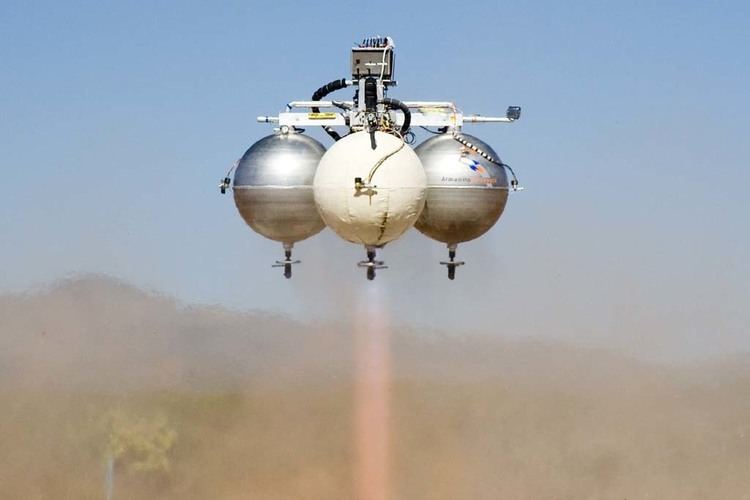Vertical takeoff, vertical landing (VTVL) is a form of takeoff and landing for rockets. Multiple VTVL craft have flown. As of 2016, VTVL is under intense development as a technology for reusable rockets, with two companies, Blue Origin and SpaceX, both having demonstrated recovery of launch vehicles after return to the launch site (RTLS) operations, with Blue Origin's New Shepard booster rocket making the first successful vertical landing following a test flight that reached outer space, and SpaceX's Falcon 9 Flight 20 marking the first landing of a commercial orbital booster, both in late 2015.
VTVL rockets are not to be confused with aircraft which take off and land vertically which use the air for support and propulsion, such as helicopters and jump jets which are VTOL aircraft.
1961 Bell Rocket Belt, personal VTVL rocket belt demonstrated.VTVL rocket concepts were studied by Philip Bono of Douglas Aircraft Co. in the 1960s.Apollo Lunar Module was a 1960s two-stage VTVL vehicle for landing and taking off from the moon.The Soviet Union did some development work on, but never flew, a vertically-landing manned capsule called Zarya in the late 1980s.The McDonnell Douglas DC-X was an unmanned prototype VTVL launch vehicle that flew several successfully test flights in the 1990s. In June 1996, the vehicle set an altitude record of 3,140 metres (10,300 ft), before making a vertical landing.Between 1998 and 2003 the Japanese Space Agency (JAXA) developed and flew a number of VTVL rocket vehicles in the Reusable Vehicle Testing programRotary Rocket successfully tested a vertical landing system for their Roton design, based around a rocket tipped helicopter system in 1999, but were unable to raise funds to build a full vehicle.During 2006-2009, Armadillo Aerospace's Scorpius / Super Mod, Masten Space Systems' Xombie and Unreasonable Rocket's Blue Ball flying VTVL rockets competed in the Northrop Grumman / NASA Lunar Lander Challenge. Follow-on VTVL designs including Masten's Xaero and Armadillo's Stig were aimed at higher-speed flight to higher suborbital altitudes.SpaceX announced plans in 2010 to eventually install deployable landing gear on the Dragon spacecraft and use the vehicle's thrusters to perform a land-based landing.In 2010, three VTVL craft were proffered to NASA in response to NASA's suborbital reusable launch vehicle (sRLV) solicitation under NASA's Flight Operations Program: the Blue Origin New Shepard, the Masten Xaero, and the Armadillo Super Mod.Morpheus is a 2010s NASA project developing a vertical test bed that demonstrates new green propellant propulsion systems and autonomous landing and hazard detection technology.Mighty Eagle is a 2010s Robotic Prototype Lander being developed by NASASpaceX announced in September 2011 that they would attempt to develop powered descent and recovery of both Falcon 9 stages, with a VTVL Dragon capsule as well.SpaceX's Grasshopper was a VTVL first-stage booster test vehicle developed to validate various low-altitude, low-velocity engineering aspects of its large-vehicle reusable rocket technology. The test vehicle made eight successful test flights in 2012–2013. Grasshopper v1.0 made its eighth, and final, test flight on October 7, 2013, flying to an altitude of 744 metres (2,441 ft) (0.46 miles) before making its eighth successful VTVL landing.SpaceX's Falcon 9 Reusable Development Vehicle was approximately 50 feet longer than Grasshopper, and is built on their full-size Falcon 9 v1.1 booster tank, with flight-design landing legs and gaseous nitrogen thrusters to control the booster attitude. F9R Dev1 made its first test flight in April 2014, to an altitude of 250 meters (820 ft) before making a nominal vertical landing.2013: SpaceX's DragonFly is a prototype low-altitude rocket-powered test article for a propulsively-landed version of their Dragon space capsule. The DragonFly is a suborbital reusable launch vehicle (RLV), intended for low-altitude flight testing expected to start in 2014 and run through at least 2015.On November 23, 2015, Blue Origin's New Shepard booster rocket made the first successful vertical landing following an unmanned suborbital test flight that reached space.On December 21, 2015, SpaceX's 20th Falcon 9 first stage made a successful landing after boosting 11 commercial satellites to low earth orbit on Falcon 9 Flight 20.On April 8, 2016, SpaceX's Falcon 9 made the first successful landing on their Autonomous spaceport drone ship as part of the SpaceX CRS-8 cargo resupply mission to the International Space Station.The technology required to successfully achieve VTVL has several parts. First, thrust must be greater than weight, second the thrust is normally required to be vectored and requires some degree of throttling. Guidance must be capable of calculating the position and attitude of the vehicle, small deviations from the vertical can cause large deviations of the vehicles horizontal position. RCS systems are usually required to keep the vehicle at the correct angle. Landing legs and deployment mechanisms add to the weight of the vehicle compared to expendable vehicles, which can reduce performance. Aerodynamics and mass distribution are also crucial; vehicles generally have to be nose heavy during ascent, but need to be stable during landing, usually on their tail, and after touchdown, where they are susceptible to winds.
It can also be necessary to be able to ignite engines in a variety of conditions potentially including vacuum, hypersonic, supersonic, transonic, and subsonic.
Elon Musk has discussed the potential for substantial reductions in space flight costs as a result of being able to reuse rockets after successful VTVL landings.
Vertical landing of spaceships was the predominant mode of rocket landing envisioned in the pre-spaceflight era. Many science fiction authors as well as depictions in popular culture showed rockets landing vertically, typically resting after landing on the space vehicle's fins. This view was sufficiently ingrained in popular culture that in 1993, following a successful low-altitude test flight of a prototype rocket, a writer opined: "The DC-X launched vertically, hovered in mid-air ... The spacecraft stopped mid-air again and, as the engines throttled back, began its successful vertical landing. Just like Buck Rogers." In the 2010s, SpaceX rockets have likewise seen the appellation to this popular culture notion of Buck Rogers in a "Quest to Create a 'Buck Rogers' Reusable Rocket."

